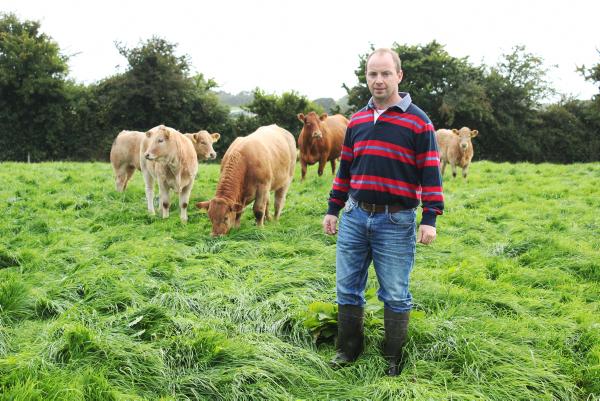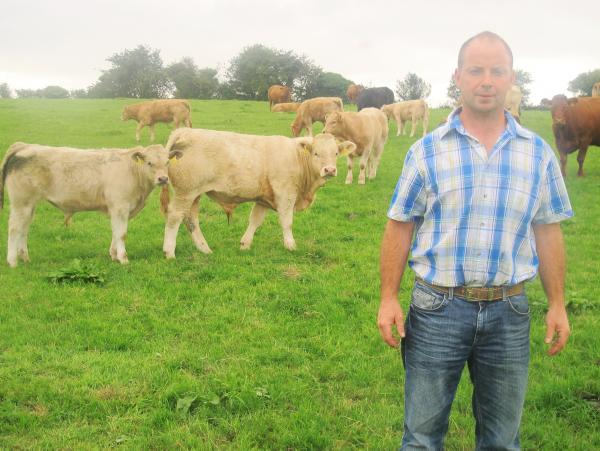On 10 September, Chris McCarthy will host a farm walk on his 28ha grassland farm close to Mullingar, Co Westmeath. Chris runs a spring-calving suckler-to-weanling system, with 55 cows calving in 2014. Cow type is mainly Limousin cross animals that are served with two Charolais stock bulls, one bred from CF52 and Balthazar.
Time management and labour are key issues in the daily running of the farm. Chris works full-time off-farm, running his own tiling business. Therefore, he is focused on keeping the system simple and hassle-free.
Compact calving, calving ease, herd health and good grazing infrastructure make the running of the herd easier to fit around off-farm employment. Chris works closely with local adviser Paul Fox and programme adviser Catherine Egan throughout the year for advice to keep his herd progressing.
A profitable weanling system is reliant on:
Calving early in spring to have heavier calves for sale in autumn.Achieving high levels of liveweight gain from grass, rather than an over-reliance on concentrates.Having cows with milk to drive weaning weights.Having calves weighing at least 350kg before selling to cover the cost of keeping the cow.Having a high level of herd health to prevent mortality in calves.Herd performance
Replacements are sourced as in-calf heifers and usually purchased from repeat sources. Heifers calve in December, which gives them plenty of time to join the main breeding herd. The additional time means there are very few cases where heifers are not successfully re-bred.
In 2014, there were 55 live calves on 55 cows. Chris vaccinates for BVD, Lepto and scour to reduce disease risks. Vaccination, combined with excellent management, resulted in zero mortality this year, which is common for the herd.
Herd fertility is good. Cows have been scanned and 50 cows are in-calf from 54 put to the bull. The four empty cows will be sold live once weaned. Calving spread has tightened into a 10-week period, starting in late January and finishing in early April.
Having calves born later than April means that weanlings are too light when sold in November.
A late spring-born calf will not achieve sufficient weight gain from grass. Instead, late spring-born calves are more reliant on concentrate feeding to prepare them for sale.
Taking a cost of €750 to maintain a suckler cow, having calves under 350kg liveweight will make it extremely difficult to generate a sale value that covers production costs and leave a profit margin.
Calf weight
For instance, two spring-born calves last year had a significant weight difference throughout the year. Both calves were quality animals, but the older calf was heavier as it benefited from its mother milking on spring grass.
The older calf was born on 8 February and weighed 319kg on 26 August, while the younger calf was born on 8 April and weighed 206kg on the same date. The difference in liveweight was carried through to sale.
Taking a sale price of €2.50/kg, the price difference was €282.50 between the two calves. The February calf had additional costs of feeding the cow indoors, but even at 40 days of feeding 2kg of ration (€330/t) and an additional 20kg of silage (€30/t) post-calving, the difference between the calves was still €232/head.
In 2014, there are 29 bull calves and 26 heifers that will be sold in autumn. Bull calves weighed 155kg on 26 May and 213kg on 10 July, which is a daily gain of 1.35kg/day.
Bulls were weighed again on 20 August and averaged 288kg, which is a daily gain of 1.42kg from their last weighing.
The heifers averaged 190kg on 10 July and, when weighed on 20 August, the group averaged 249kg. Daily liveweight gain was 1.29kg. In the past, heifers would have occasionally been carried over winter and sold in the spring to increase their sale weight, but earlier calving has eliminated this.
Preparing for sale
All calves will have creep feed introduced two weeks pre-weaning. Weaning is normally in mid-September, with cows housed for a short period while calves remain at grass. Calves are being vaccinated for pneumonia, which reduces the health risks when weaning calves.
Calves are sold directly from the yard to repeat buyers. Selling out of the yard is worth more to Chris. Calves are weighed and sold at full weight, whereas taking calves to the mart usually results in weight loss due to stress levels increasing.
When selling privately, there are also no commission fees deducted as happens in marts. Sale price is based on the mart price for similar cattle types.
Between the extra weight and lack of fees, Chris is approximately €50/head better off selling out of the yard.
Grassland management
The cows are grazed in two groups during the breeding season, but once the bulls are removed, cows run as one group. They are separated into two groups again in late summer to divide bull and heifer calves.
The farm is divided into paddocks and grass is measured weekly. Reseeding is carried out regularly, allowing the farm to carry a stocking rate of 2.2LU/ha.
Young swards are more productive and grazing ground has only received 100 unit/acre of nitrogen this season.
On 10 September, Chris McCarthy will host a farm walk on his 28ha grassland farm close to Mullingar, Co Westmeath. Chris runs a spring-calving suckler-to-weanling system, with 55 cows calving in 2014. Cow type is mainly Limousin cross animals that are served with two Charolais stock bulls, one bred from CF52 and Balthazar.
Time management and labour are key issues in the daily running of the farm. Chris works full-time off-farm, running his own tiling business. Therefore, he is focused on keeping the system simple and hassle-free.
Compact calving, calving ease, herd health and good grazing infrastructure make the running of the herd easier to fit around off-farm employment. Chris works closely with local adviser Paul Fox and programme adviser Catherine Egan throughout the year for advice to keep his herd progressing.
A profitable weanling system is reliant on:
Calving early in spring to have heavier calves for sale in autumn.Achieving high levels of liveweight gain from grass, rather than an over-reliance on concentrates.Having cows with milk to drive weaning weights.Having calves weighing at least 350kg before selling to cover the cost of keeping the cow.Having a high level of herd health to prevent mortality in calves.Herd performance
Replacements are sourced as in-calf heifers and usually purchased from repeat sources. Heifers calve in December, which gives them plenty of time to join the main breeding herd. The additional time means there are very few cases where heifers are not successfully re-bred.
In 2014, there were 55 live calves on 55 cows. Chris vaccinates for BVD, Lepto and scour to reduce disease risks. Vaccination, combined with excellent management, resulted in zero mortality this year, which is common for the herd.
Herd fertility is good. Cows have been scanned and 50 cows are in-calf from 54 put to the bull. The four empty cows will be sold live once weaned. Calving spread has tightened into a 10-week period, starting in late January and finishing in early April.
Having calves born later than April means that weanlings are too light when sold in November.
A late spring-born calf will not achieve sufficient weight gain from grass. Instead, late spring-born calves are more reliant on concentrate feeding to prepare them for sale.
Taking a cost of €750 to maintain a suckler cow, having calves under 350kg liveweight will make it extremely difficult to generate a sale value that covers production costs and leave a profit margin.
Calf weight
For instance, two spring-born calves last year had a significant weight difference throughout the year. Both calves were quality animals, but the older calf was heavier as it benefited from its mother milking on spring grass.
The older calf was born on 8 February and weighed 319kg on 26 August, while the younger calf was born on 8 April and weighed 206kg on the same date. The difference in liveweight was carried through to sale.
Taking a sale price of €2.50/kg, the price difference was €282.50 between the two calves. The February calf had additional costs of feeding the cow indoors, but even at 40 days of feeding 2kg of ration (€330/t) and an additional 20kg of silage (€30/t) post-calving, the difference between the calves was still €232/head.
In 2014, there are 29 bull calves and 26 heifers that will be sold in autumn. Bull calves weighed 155kg on 26 May and 213kg on 10 July, which is a daily gain of 1.35kg/day.
Bulls were weighed again on 20 August and averaged 288kg, which is a daily gain of 1.42kg from their last weighing.
The heifers averaged 190kg on 10 July and, when weighed on 20 August, the group averaged 249kg. Daily liveweight gain was 1.29kg. In the past, heifers would have occasionally been carried over winter and sold in the spring to increase their sale weight, but earlier calving has eliminated this.
Preparing for sale
All calves will have creep feed introduced two weeks pre-weaning. Weaning is normally in mid-September, with cows housed for a short period while calves remain at grass. Calves are being vaccinated for pneumonia, which reduces the health risks when weaning calves.
Calves are sold directly from the yard to repeat buyers. Selling out of the yard is worth more to Chris. Calves are weighed and sold at full weight, whereas taking calves to the mart usually results in weight loss due to stress levels increasing.
When selling privately, there are also no commission fees deducted as happens in marts. Sale price is based on the mart price for similar cattle types.
Between the extra weight and lack of fees, Chris is approximately €50/head better off selling out of the yard.
Grassland management
The cows are grazed in two groups during the breeding season, but once the bulls are removed, cows run as one group. They are separated into two groups again in late summer to divide bull and heifer calves.
The farm is divided into paddocks and grass is measured weekly. Reseeding is carried out regularly, allowing the farm to carry a stocking rate of 2.2LU/ha.
Young swards are more productive and grazing ground has only received 100 unit/acre of nitrogen this season.






 This is a subscriber-only article
This is a subscriber-only article











SHARING OPTIONS: